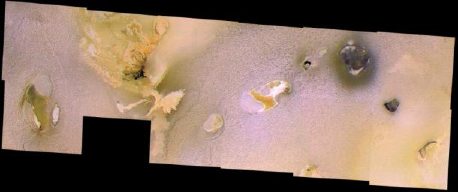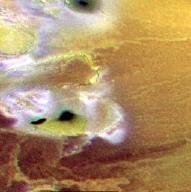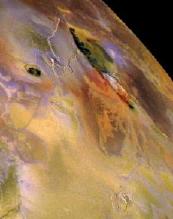Calderas and Lava Lakes
Io's calderas tend to be larger than those found on Earth, but they display many other similar features. They are roughly circular, deep, steep-sided, and many have dark material on their floors, which is an indication that hot, fresh lava is present. Some of the calderas appear to have a collapsed floor, as if the material supporting them had drained away.

Some of the volcanic centers on Io are different in character from calderas found elsewhere in the solar system. These are called patera. While they are volcanic in origin, many of the patera have straight edges and sharp angles indicating they may be related to fractures and movement in the crust. The image above is a mosaic of a region covering about 850 kilometers (509 miles) where nine paterae can be seen.
 This
image is of Chaac Patera, seen in the lower left corner of
the mosaic. It is approximately 100 km (63 miles) long and
30 km (19 miles) across. One of the caldera walls in Chaac
is about 2.8 km (1.7 miles) high with a 70 degree slope.
This is about twice as high and steep as the walls of the
Grand Canyon. In the southernmost area, several raised
plateaus and a deep, dark pit are visible. Similar features
were seen during the 1959 eruption of the Kilauea volcano in
Hawaii when a pond was formed as erupting lava filled in a
small volcanic crater. As the pond crusted over, lava
drained back into the ground leaving behind a perched
plateau. The floor of Chaac patera has interwoven domes and
pits making it virtually identical to calderas on Earth that
erupt fluid lavas.
This
image is of Chaac Patera, seen in the lower left corner of
the mosaic. It is approximately 100 km (63 miles) long and
30 km (19 miles) across. One of the caldera walls in Chaac
is about 2.8 km (1.7 miles) high with a 70 degree slope.
This is about twice as high and steep as the walls of the
Grand Canyon. In the southernmost area, several raised
plateaus and a deep, dark pit are visible. Similar features
were seen during the 1959 eruption of the Kilauea volcano in
Hawaii when a pond was formed as erupting lava filled in a
small volcanic crater. As the pond crusted over, lava
drained back into the ground leaving behind a perched
plateau. The floor of Chaac patera has interwoven domes and
pits making it virtually identical to calderas on Earth that
erupt fluid lavas.
 The
three dark spots in this image of Io's south polar region
are volcanic calderas that range from 10 to 20 km (6 to 13
miles) across. The dark floors are assumed to be recent lava
flows, and the dark material surrounding the calderas may be
material which was thrown out during explosive eruptions.
The yellow lava flow at the southern edge of the image
appears to be connected to a caldera by a dark channel. This
lava flow is thought to be composed of sulfur rather than
silicate materials.
The
three dark spots in this image of Io's south polar region
are volcanic calderas that range from 10 to 20 km (6 to 13
miles) across. The dark floors are assumed to be recent lava
flows, and the dark material surrounding the calderas may be
material which was thrown out during explosive eruptions.
The yellow lava flow at the southern edge of the image
appears to be connected to a caldera by a dark channel. This
lava flow is thought to be composed of sulfur rather than
silicate materials.
 This
image of Zal Patera shows the edge of a caldera (center top)
which is marked by black flows. The red areas are associated
with places where hot lava is erupting onto the surface. The
red material appears to follow the base of a mountain, which
may indicate that sulfurous gases are escaping along a
fault.
This
image of Zal Patera shows the edge of a caldera (center top)
which is marked by black flows. The red areas are associated
with places where hot lava is erupting onto the surface. The
red material appears to follow the base of a mountain, which
may indicate that sulfurous gases are escaping along a
fault.
Photo Credits: NASA/JPL
